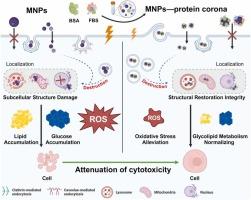聚苯乙烯微塑料和纳米塑料在斑马鱼肝细胞中的命运:蛋白质电晕对运输、氧化应激和糖脂代谢的影响
IF 11.3
1区 环境科学与生态学
Q1 ENGINEERING, ENVIRONMENTAL
引用次数: 0
摘要
微和纳米塑料(MNPs)在与生物流体接触后形成蛋白冠(PC),但它们对MNPs的细胞内运输、分布和毒性的影响尚不清楚。采用胎牛血清(FBS)和牛血清白蛋白(BSA)模拟体内环境,探讨其对聚苯乙烯(PS) MNPs在斑马鱼肝脏(ZFL)细胞内转运和毒性的影响。结果表明,PS MNPs被蛋白包裹成稳定的复合物。纳米颗粒(NP, 50 nm)及其蛋白质复合物(NP@PC)在6 h内被细胞内化,PC的形成增强了NP的摄取。NP主要通过网格蛋白和小泡介导的内吞作用进入细胞,而NP@PC则通过网格蛋白介导的途径进入细胞。内化颗粒主要存在于PC降解的溶酶体中,也有一些存在于线粒体中。最终,颗粒通过能量依赖的溶酶体途径和能量独立的膜穿透机制从细胞中排出。值得注意的是,PC的形成限制了NP的清除。在毒性方面,NP比微塑料(MP, 5 μm)的影响更严重。FBS比BSA更有效地减轻了PS mnps诱导的活性氧积累、亚细胞结构损伤和糖脂代谢失调。本研究阐明了PC对MNPs生物效应的调节作用,提供了安全和风险管理策略。本文章由计算机程序翻译,如有差异,请以英文原文为准。

Fate of polystyrene micro- and nanoplastics in zebrafish liver cells: Influence of protein corona on transport, oxidative stress, and glycolipid metabolism
Micro- and nanoplastics (MNPs) form protein corona (PC) upon contact with biological fluids, but their impact on the intracellular transport, distribution, and toxicity of MNPs remains unclear. Fetal bovine serum (FBS) and bovine serum albumin (BSA) were used to simulate in vivo environment, this study explored their influence on the transport and toxicity of polystyrene (PS) MNPs in zebrafish liver (ZFL) cells. Results showed PS MNPs were wrapped by proteins into stable complexes. Nanoparticles (NP, 50 nm) and their protein complexes (NP@PC) were internalized by cells within 6 h, with PC formation enhancing NP uptake. NP primarily entered cells through clathrin- and caveolae-mediated endocytosis, while NP@PC via clathrin-mediated pathways. Internalized particles were predominantly in lysosomes where PC degraded and some were also in mitochondria. Eventually, particles were expelled from cells through energy-dependent lysosomal pathways and energy-independent membrane penetration mechanisms. Notably, PC formation limited the clearance of NP. In toxicity, NP had a more severe impact than microplastics (MP, 5 μm). FBS more effectively mitigated PS MNPs-induced reactive oxygen species accumulation, subcellular structural damage, and dysregulation of glycolipid metabolism than BSA did. This study elucidates the modulatory role of PC on biological effects of MNPs, providing safety and risk management strategies.
求助全文
通过发布文献求助,成功后即可免费获取论文全文。
去求助
来源期刊

Journal of Hazardous Materials
工程技术-工程:环境
CiteScore
25.40
自引率
5.90%
发文量
3059
审稿时长
58 days
期刊介绍:
The Journal of Hazardous Materials serves as a global platform for promoting cutting-edge research in the field of Environmental Science and Engineering. Our publication features a wide range of articles, including full-length research papers, review articles, and perspectives, with the aim of enhancing our understanding of the dangers and risks associated with various materials concerning public health and the environment. It is important to note that the term "environmental contaminants" refers specifically to substances that pose hazardous effects through contamination, while excluding those that do not have such impacts on the environment or human health. Moreover, we emphasize the distinction between wastes and hazardous materials in order to provide further clarity on the scope of the journal. We have a keen interest in exploring specific compounds and microbial agents that have adverse effects on the environment.
 求助内容:
求助内容: 应助结果提醒方式:
应助结果提醒方式:


